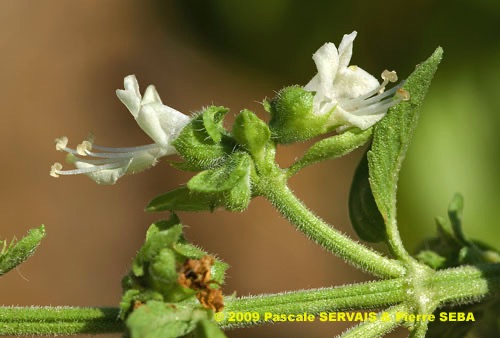
Ocimum basilicum L.
Fam. : Lamiaceae
© Pascale SERVAIS & Pierre SEBA, 2018. Tilo Botanica: Flore de Tilos et du Dodécanèse / Flora of Tilos and of the Dodecanese
English translation by Brenda Bradbury, Howard Bradbury and Stéphane Léonard
Plante herbacée, ligneuse à la base, hermaphrodite, aromatique, à tiges dressées, ramifiées, poilues.
Feuilles opposées décussées, simples, elliptiques à ovales, dentées, glabres, pétiolées, de 5 à 10 cm de long, fortement aromatiques.
Fleurs à symétrie bilatérale, blanches, à 2 lèvres, d’environ 1 cm de long, réunies en verticilles de 20 à 25 mm de diamètre. Corolle à 5 pétales soudés, à lèvre inférieure à 4 dents. Calice à 5 sépales soudés, poilus, inégaux. 4 étamines saillantes. Ovaire supère.
Fruits, 4 akènes insérés à la base du calice persistant. Graines fines, oblongues, noires.
___________________________
Plant herbaceous, woody at the base, hermaphrodite, aromatic. Stems erect, branched, hairy.
Leaves opposite decussate, simple, elliptic to ovate, toothed, glabrous, petiolate, from 5 to 10 cm long, strongly aromatic.
Flowers bilaterally symmetrical, white, with 2 lips, of approximately 1 cm long, joined together in whorls from 20 to 25 mm in diameter. Corolla with 5 fused petals, the lower lip with 4 teeth. Calyx with 5 fused, hairy, unequal sepals. 4 protruding stamens. Ovary superior.
Fruits, 4 achenes inserted into the base of the persistent calyx. Seeds fine, oblong, black.
Descripteurs / Identifying features
1
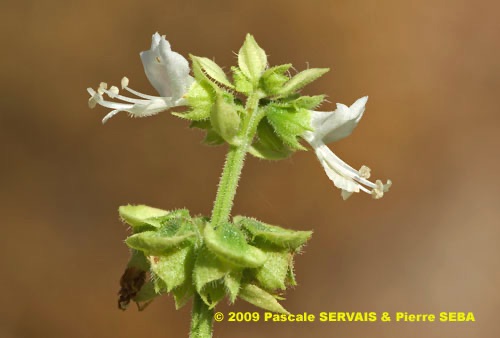
2

3
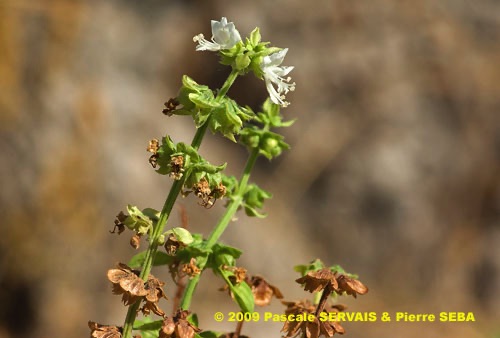
4
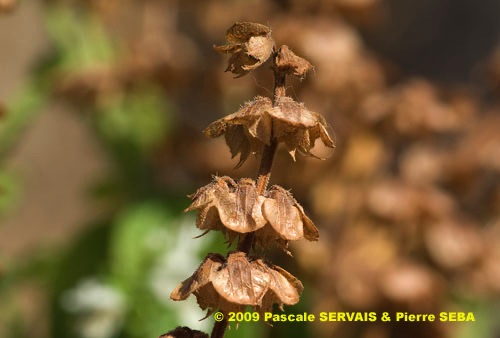
5
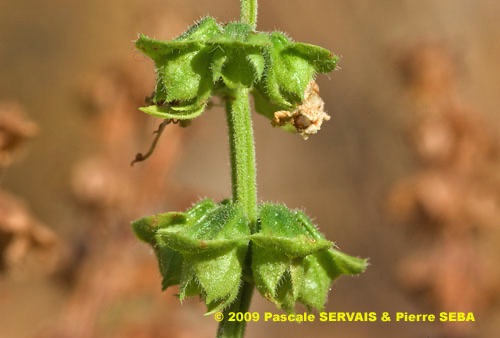
6
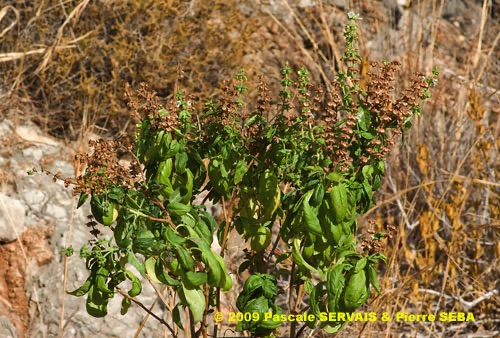
7
Étymologie / Etymology :
Ocimum : emprunt du latin ocimum, -i (nom) = le basilic, nom donné à
la plante par Pline, naturaliste latin mort en 79 apr. J.-C., forme
latinisée du grec ancien ὤκινον, -ου (nom) = le basilic, nom donné à
la plante par Dioscoride, médecin et botaniste grec mort
en 90 apr. J.-C.
Basilicum : emprunt du latin basilicus, -a, -um (adj.) = royal, magnifique,
forme latinisée du grec ancien βασιλικός, -ή, -όν (adj.)
[ < βασιλεύς, -έως (nom) = le roi ] = royal, digne d’un roi.
Ocimum : borrowed from Latin ocimum, -i (noun) = basil, name given to
the plant by Plinius, Latin naturalist died in 79 AD, Latinized form of the
Classical Greek ὤκινον, -ου (noun) = basil, name given to the plant by
Dioscorides, Greek doctor and botanist died in 90 AD.
Basilicum : borrowed from Latin basilicus, -a, -um (adj) = royal, beautiful,
Latinized form of the Classical Greek βασιλικός, -ή, -όν (adj)
[ < βασιλεύς, -έως (noun) = king ] = royal, worthy of a king.
Synonymes / Synonyms :
Basilicum polystachion (L.) Moench
Ocimum album L.
Ocimum americanum L.
Ocimum barrelieri Roth
Ocimum basilicum var. album Benth.
Ocimum basilicum var. anisatum Benth.
Ocimum basilicum var. densiflorum Benth.
Ocimum basilicum var. difforme Benth.
Ocimum basilicum var. glabratum Benth.
Ocimum basilicum var. majus Benth.
Ocimum basilicum var. pilosum (Willd.) Benth.
Ocimum basilicum var. purpurascens Benth.
Ocimum basilicum var. thyrsiflorum (L.) Benth.
Ocimum caryophyllatum Roxb.
Ocimum citriodorum Blanco
Ocimum cochleatum Desf.
Ocimum dichotomum Benth.
Ocimum hispidum Lam.
Ocimum integerrimum Willd.
Ocimum lanceolatum Schumach. & Thonn.
Ocimum medium Mill.
Ocimum minimum L Mill.
Ocimum odorum Salisb.
Ocimum pilosum Willd.
Ocimum thyrsiflorum L.
Noms vernaculaires / Common names :
Noms français / French names :
Basilic — Basilic aux sauces — Basilic commun —
Basilic romain — Framboisin — Grand basilic — Herbe royale —
Oranger des savetiers — Pistou.
Noms grecs / Greek names :
Βασιλικό — Βασιλικός — Βασιλιτσά — Σταυρολούλουδο —
Ώκιμο το βασιλικό.
Noms anglais / English names :
Basil — Common basil — Garden basil — Roman basil — Sweet basil.
Noms allemands / German names :
Basilienhraut — Basilikum — Echtes Basilienkraut —
Gartenhirnkraut — Gewöhnliches Basilienkraut — Königskraut.
Noms espagnols / Spanish names :
Albacar — Albahaca — Albahaca común — Albahaca silvestre —
Alhábega — Ocimo.
Nom italien / Italian name :
Basilico.
Habitat :
Jardins.
Gardens.
Île / Island :
Tilos.
Hauteur / Height range :
De 20 cm à 50 cm.
From 20 cm to 50 cm.
Floraison / Flowering time :
De juin à octobre.
From June to October.
Groupe / Classification :
Dicotylédones.
Dicotyledons.
Pérennité / Lifespan :
Annuelle.
Annual.
Description :
Photo 1 :
Localisation / Location : Tilos, Livadia, Village
Date : 20/10/2009
GPS : Lat. 36,41921° N / Long. 27,38632° E / Alt. 22 m
Type : Photographie numérique / Digital Photograph (10 mégapixels)
Photo 2 :
Localisation / Location : Tilos, Livadia, Village
Date : 20/10/2009
GPS : Lat. 36,41921° N / Long. 27,38632° E / Alt. 22 m
Type : Photographie numérique / Digital Photograph (10 mégapixels)
Photo 3 :
Localisation / Location : Tilos, Livadia, Village
Date : 20/10/2009
GPS : Lat. 36,41921° N / Long. 27,38632° E / Alt. 22 m
Type : Photographie numérique / Digital Photograph (10 mégapixels)
Photo 4 :
Localisation / Location : Tilos, Livadia, Village
Date : 20/10/2009
GPS : Lat. 36,41921° N / Long. 27,38632° E / Alt. 22 m
Type : Photographie numérique / Digital Photograph (10 mégapixels)
Photo 5 :
Localisation / Location : Tilos, Livadia, Village
Date : 20/10/2009
GPS : Lat. 36,41921° N / Long. 27,38632° E / Alt. 22 m
Type : Photographie numérique / Digital Photograph (10 mégapixels)
Photo 6 :
Localisation / Location : Tilos, Livadia, Village
Date : 20/10/2009
GPS : Lat. 36,41921° N / Long. 27,38632° E / Alt. 22 m
Type : Photographie numérique / Digital Photograph (10 mégapixels)
Photo 7 :
Localisation / Location : Tilos, Livadia, Village
Date : 20/10/2009
GPS : Lat. 36,41921° N / Long. 27,38632° E / Alt. 22 m
Type : Photographie numérique / Digital Photograph (10 mégapixels)

Google Maps
Google Maps
Google Maps
Google Maps
Google Maps
Google Maps
Google Maps